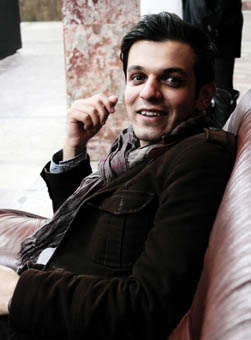
For the first time in Valencia, it will be shown, on Friday 27 May, the documentary ‘Writing on the City’ (2012), a film for which the Iranian filmmaker Keywan Karimi was sentenced by the justice of his country to six years in prison and 223 lashes. The film, that was released in Spain in the framework of the Punto de Vista - International Documentary Film Festival od Navarra, will be shown at the Aula Maga of La Nau, at 19 hours, in a special session organised by the Cinema Club of the Universitat and with the collaboration of Amnesty International Valencia. The act will be presented by Natxo Almela, from the Cinema Club, and Carmen Soto on behalf of Amnesty International Valencia.
Considered one of the most promising filmmakers of his country, Keywan Karimi (Teheran, 1985) has suffered the censorship and persecution of the Islamic authorities of his country. In 2013, he spent 12 days in Evin prison after the authorities confiscated him a compact disc that contained a music clip which, presumably, insulted the regime. Afterwards, in September 2015, he was brought to justice again and accused of insulting Islam and of ‘propaganda against the system’. The sentence was severe: six years in prison (that had been reduced to one year) and 223 lashings. The cause was none other than the film ‘Writing on the City’, which Karimi made long ago and had not even been displayed, apart from a trailer available on YouTube.
‘Writing on the City’ is a documentary that goes over the recent history of Teheran, related through paintings and inscriptions that decorate its walls and façades. During the revolution of 1978-79, the words written on the walls served as a modest protest against the Shah’s regime. Once the revolution succeed and the Islamic Republic was founded, the inscriptions began to show divided opinions and progressively were replaced by propaganda pictures, such as the faces of those martyrs who fought in the war against Iraq during the decade of 1980.
The Ayatollah regime started getting more and more severe and authoritarian, and the walls -which had always had a great ability of communicating and influencing people- showed the severe and omnipresent image of Khomeini or were decorating with natural and rural motifs increasingly deteriorated buildings. In 2009, after the protests against the re-election of Mahmoud Ahmadineyad as president of the country, that ended with dozens of deaths, the germ of vindication is again present in the walls that, this time, the youngest are in charge of covering. New generations and new styles like graffiti that try to avoid the best they can the sever censorship of authorities and that survive practically in the underground.
This way, Karimi is just one more in the long list of victims of the injustice of those that expect to control even the smallest trace of dissidence and heterodoxy. The outrages and abuses of the Iranian regime have been reported in multiple occasions by organisations that watch over the compliance of human rights, and in the case of Karimi there have also joined the voices of 223 filmmakers from all over the world that wanted to say a word in the defence of the young producer that form the film ‘223 Words’, a necessary document in order to not forget that in many places of the world there is still people that suffers for the simple fact of telling the reality that surrounds them.
Last update: 26 de may de 2016 10:49.
News release



















